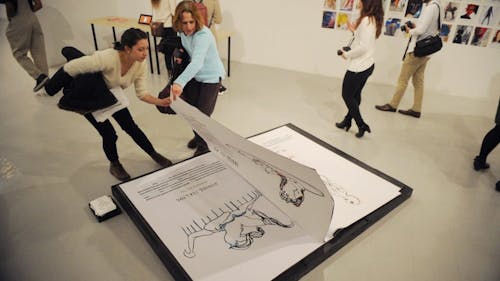Wabi Sabi design show exhibits feast for your senses

Bachelor of Fine Arts (BFA) in Design students formally unveiled their work at the opening reception for the Wabi Sabi Thesis Exhibition on March 23, marking the date for the first ever design-only thesis show hosted by the Mason Gross School of the Arts.
At the exhibition, visitors senses were marinated by the wealth of diverse pieces. The highly interactive and cerebral pieces were aesthetically strung across the floors and against the walls of the Livingston street-located gallery.
Upon entering the gallery, my eyes took a quick tour of the rooms. There was a wall strewn with controversial political messages and an artist’s written plea for visitors to vandalize the wall, a new take on a children’s book, prints, magazines and a surveillance interactive station. I was quite intrigued and overwhelmed by it all.
Rais Ahmed, a Mason Gross School of the Arts senior, was one artist part of Wabi Sabi. Ahmed’s piece is called “Midpoint,” which is his name for an app that does exactly what the name suggests. It locates middle points for a pair of people looking to meet up for any reason — from a safe venue for a Craigslist exchange or for a sensible date spot to score some yummy pizza with your latest Bumble babe.
“Midpoint has got you covered,” Ahmed said on wabisabi.show website.
Ahmed was also the artist who pitched the name for the show, Wabi Sabi, which he said fit in perfectly with the work of all the artists.
“Wabi Sabi came up, and what it means is the acceptance of the natural cycle, the growth and decay, building up and breaking down,” he said. “So, the way I related that to our show is that we’re all designers and we all go through trends, and we live in a digital age, so there are always trends that build and break down, and then new ones come up.”
Wabi Sabi is also a Japanese worldview centered on the acceptance of transience and imperfection, which the artists thought dovetailed perfectly with their works.
Located right next to Ahmed’s piece is a work by Khirsten Harper, a Mason Gross School of the Arts senior. Harper’s aesthetically pleasing work is titled “Beauty Redefined.”
“It is a collection of a hundred silk-screen prints, and the majority of them are on top of magazine pages that I got from high-fashion magazines,” Harper said. “And what my project is about is really combatting Eurocentric beauty standards, and I’m addressing how they impact women of color.”
The different standards she addressed include body type, skin color, facial features and hair texture, which are things she wanted to address by imposing her own standards and definitions of beauty, she said.
After spending some time with Harper’s piece, beautifully sprawled across a wall, I found my way over to the rear gallery to the left, where a piece by Devayani Kumaran, a Mason Gross School of the Arts senior, was set up. Her piece is called “Dusky and Lovely,” a mock-campaign against skin-whitening treatments.
“Within my culture, the Indian culture, there is a product called ‘Fair and Lovely,’ which has the message saying that fairer skin is more beautiful. Also within our culture there is a term called ‘dusky,’ which means darker skin and is usually used in a negative way,” Kumaran said.
Kumaran wanted to encompass all women of color and to celebrate them, she said. Additionally, with her work she would like to change the negative meaning of dusky to a more positive one, which is why her piece is called “Dusky and Lovely.”
In her piece, she interviewed 10 women of color of different ethnicities and spoke to them about the negative impact of skin-whitening treatments. She then put their responses into booklets, and additionally presented the interviews on the wall to be read.
I only had the chance to speak with a few of the artists about their pieces and their take on the opening — each one of them was excited to see not only their work, but the work of their peers come to fruition. The excited energy beaming among the artists throughout the gallery was pervasive.
The gallery-goers seemed to enjoy their time interacting with the pieces as well. Whether this meant flipping the pages of a large anti-yoga book, gazing at interviews on a wall or vandalizing a wall, the curiosity of the visitors was expansive.
After a night of exploration at the first-of-its-kind thesis exhibition, it can perhaps be safe to say the work of the University’s artists mentally found its way to the visitors’ homes, too.
The pieces can be seen at the Civic Square Building gallery, which will be open for limited hours through April 8.



